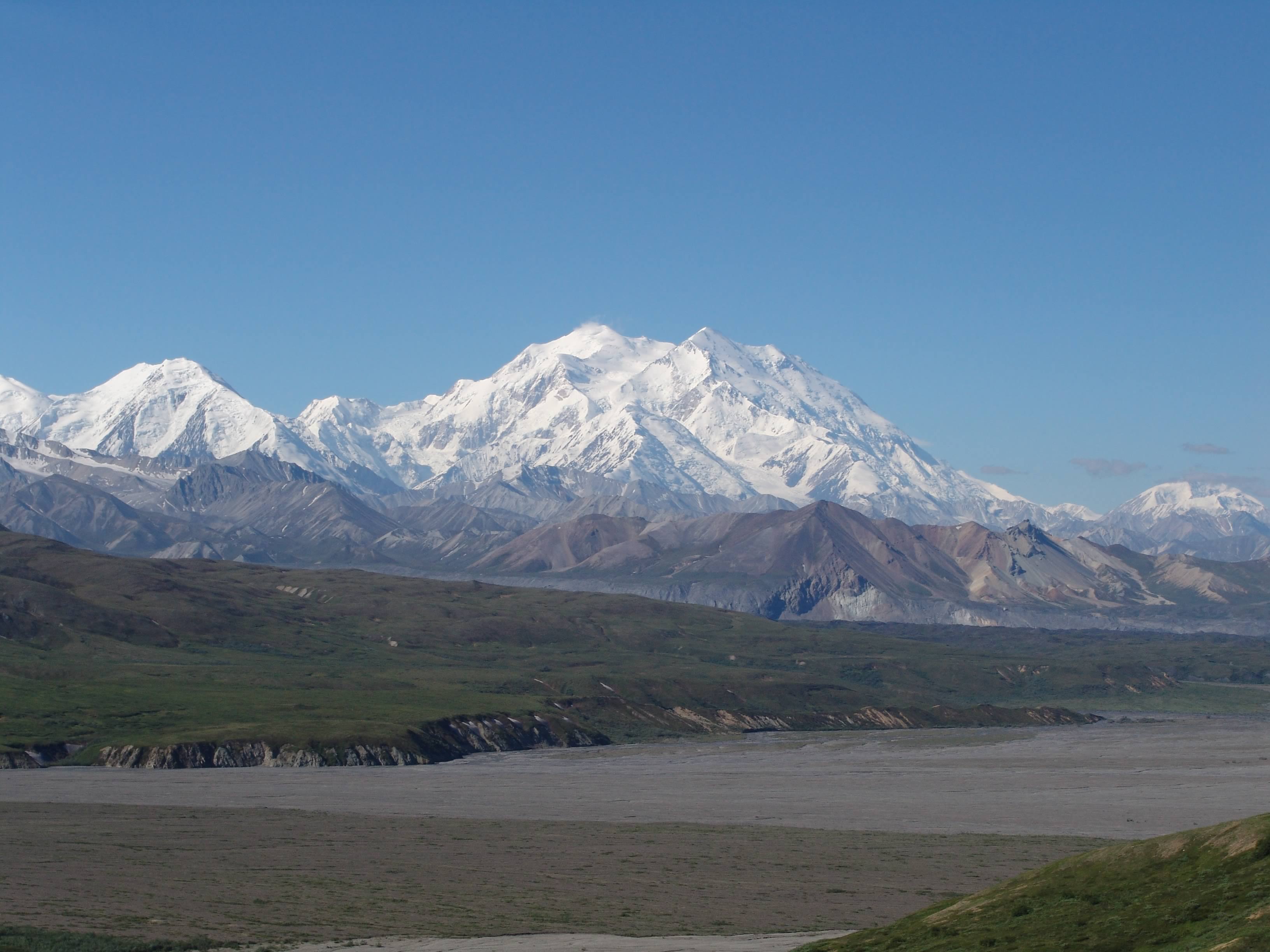- Alaska Range
Geobox|Range
name=Alaska Range

image_caption=Mount McKinley, on a rare clear day
etymology=
country=United States
state=Alaska
unit=
border=Pacific Coast Ranges
geology= | period= | orogeny=
length_imperial=| length_orientation=
width_imperial= | width_orientation=
highest=Mount McKinley
highest_elevation_imperial=20320
highest_lat_d=63|highest_lat_m=04|highest_lat_s=10|highest_lat_NS=N
highest_long_d=151|highest_long_m=00|highest_long_s=26|highest_long_EW=W
map_caption=The Alaska Range is a relatively narrow, 650-km-long (400 mi)mountain range in the southcentral region of theU.S. state ofAlaska , fromLake Clark at its southwest endSources differ as to the exact delineation of the Alaska Range. The [http://geonames.usgs.gov/domestic/index.html Board on Geographic Names] entry is inconsistent; part of it designatesIliamna Lake as the southwestern end, and part of the entry has the range ending at the Telaquana and Neacola Rivers. Other sources identify Lake Clark, in between those two, as the endpoint. This also means that the status of theNeacola Mountains is unclear: it is usually identified as the northernmost subrange of theAleutian Range , but it could also be considered the southernmost part of the Alaska Range.] to the White River inCanada 'sYukon Territory in the southeast. The highest mountain inNorth America ,Mount McKinley , is in the Alaska Range.The range forms a generally east-west arc with its northernmost part in the center, and from there trending southwest towards the
Alaska Peninsula and the Aleutians, and trending southeast into thePacific Coast Ranges . The mountains act as a high barrier to the flow of moist air from theGulf of Alaska northwards, and thus has some of the harshest weather in the world. The heavy snowfall also contributes to a number of largeglacier s, including the Canwell, Castner, Black Rapids, Susitna, Yanert, Muldrow, Eldridge, Ruth, Tokositna, and Kahiltna Glaciers. Four major rivers cross the Range, including theDelta River , andNenana River in the center of the range and the Nabesna and Chisana Rivers to the east.The range is part of the
Pacific Ring of Fire , and theDenali Fault that runs along the southern edge of the range is responsible for a number ofearthquake s. However, there are no volcanoes in the range but several large granite plutons.Parts of the range are protected within
Wrangell-St. Elias National Park and Preserve ,Denali National Park and Preserve , andLake Clark National Park and Preserve . TheGeorge Parks Highway from Anchorage to Fairbanks, theRichardson Highway from Valdez to Fairbanks, and theTok Cut-Off from Gulkana Junction toTok, Alaska pass through low parts of the range. TheAlaska Pipeline parallels theRichardson Highway .The name "Alaskan Range" appears to have been first applied to these mountains in 1869 by naturalist
W. H. Dall . The name eventually became "Alaska Range" through local use. In 1849Constantin Grewingk applied the name "T schigmit" to this mountain range. A map made by theGeneral Land Office in 1869 calls the southwestern part of the Alaska Range the "Chigmit Mountains" and the northeastern part the "Beaver Mountains".Name history from the [http://geonames.usgs.gov/domestic/index.html Board on Geographic Names] entry for the Alaska Range.] However theChigmit Mountains are now considered part of theAleutian Range .Major peaks
*
Mount McKinley (6,194 m/20,320 ft)
*Mount Foraker (5,304 m/17,400 ft)
* Mount Hunter (4,442 m/14,573 ft)
*Mount Hayes (4,216 m/13,832 ft)
* Mount Silverthrone (4,029 m/13,218 ft)
*Mount Deborah (3,761 m/12,339 ft)
* Mount Huntington (3,730 m/12,240 ft)
* Mount Russell (3,557 m/11,670 ft)ubranges (from west to east)
*
Neacola Mountains
*Revelation Mountains
* Teocalli Mountains
*Kichatna Mountains
* Central Alaska Range/Denali Massif
* Eastern Alaska Range/Hayes Range
* Delta Mountains
*Mentasta Mountains
* Nutzotin MountainsDocumented wilderness traverses of Alaska Range
* Mentasta Lake to Kitchatna Mountains (1981): Scott Woolums, George Beilstein, Steve Eck, and Larry Coxen by skis: first traverse. 375 miles in 45 days. [ American Alpine Journal (1982), Vol. 24. Pages 137-138]
* Canada to Lake Clark (1996): Roman Dial, Carl Tobin, and Paul Adkins by mountain bike andpackraft : first full length traverse. 775 miles in 42 days. [ "A Wild Ride," National Geographic Magazine (1997), Vol. 191. Pages 118-131]
* Tok to Lake Clark (1996): Kevin Armstrong, Doug Woody, and Jeff Ottmers by snowshoe, foot, andpackraft : first foot traverse. 620 miles in 90 days. [ American Alpine Journal (1997), Vol. 39. Pages 169-170]References
Further reading
*Churkin, M., Jr., and C. Carter. (1996). "Stratigraphy, structure, and graptolites of an Ordovician and Silurian sequence in the Terra Cotta Mountains, Alaska Range, Alaska" [U.S. Geological Survey Professional Paper 1555] . Washington, D.C.: U.S. Department of the Interior, U.S. Geological Survey.
Wikimedia Foundation. 2010.
